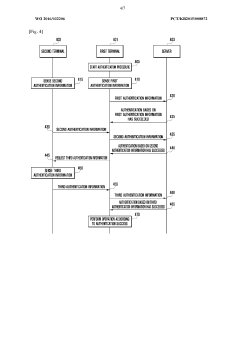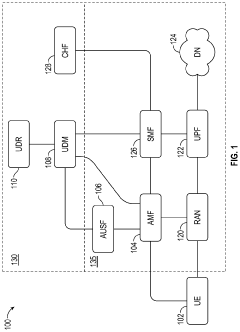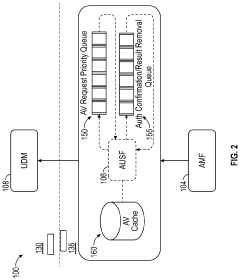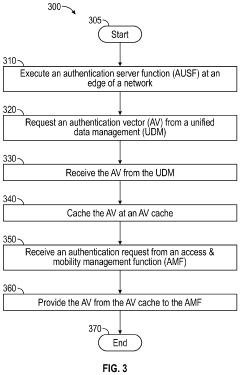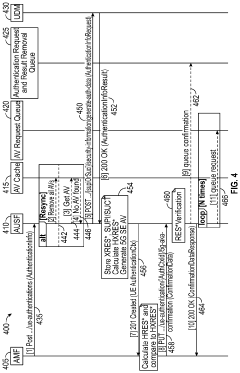Exploring the Integration of 5G UC with Biometric Authentication Systems
JUL 18, 20259 MIN READ
Generate Your Research Report Instantly with AI Agent
Patsnap Eureka helps you evaluate technical feasibility & market potential.
5G UC and Biometrics Integration Background
The integration of 5G Ultra-Capacity (UC) networks with biometric authentication systems represents a significant technological convergence that promises to revolutionize secure access and identity verification across various sectors. This fusion of advanced wireless technology and sophisticated biometric solutions is driven by the increasing demand for robust, fast, and reliable authentication methods in an increasingly digital world.
5G UC, the latest iteration of cellular network technology, offers unprecedented data speeds, ultra-low latency, and massive device connectivity. These capabilities provide an ideal foundation for enhancing biometric authentication systems, which have traditionally been limited by network constraints. The high bandwidth of 5G UC enables the rapid transmission of complex biometric data, such as high-resolution facial images or detailed fingerprint scans, while its low latency ensures near-instantaneous processing and verification.
Biometric authentication, on the other hand, has evolved from simple fingerprint recognition to encompass a wide array of modalities including facial recognition, iris scanning, voice recognition, and even behavioral biometrics. These systems offer a higher level of security compared to traditional password-based methods, as biometric traits are unique to individuals and difficult to replicate or forge.
The convergence of these two technologies addresses several key challenges in modern digital security. For instance, the increased speed and capacity of 5G UC networks can support more sophisticated multi-modal biometric systems, combining multiple biometric factors for enhanced accuracy and security. This is particularly crucial in high-security environments such as financial institutions, government facilities, and critical infrastructure.
Moreover, the integration opens up new possibilities for remote authentication. With 5G UC's ability to handle large amounts of data quickly and securely, complex biometric verification processes can be conducted in real-time, even when the user and the authentication server are geographically distant. This capability is invaluable for applications such as remote work, telemedicine, and secure online transactions.
The historical context of this integration is rooted in the parallel development of mobile networks and biometric technologies. As cellular networks evolved from 1G to 5G, biometric systems also advanced from basic fingerprint scanners to AI-powered multi-modal systems. The intersection of these trajectories at the 5G UC stage marks a pivotal moment in the evolution of secure digital identity management.
Looking forward, this integration is poised to play a crucial role in shaping the future of digital security, identity verification, and access control across various industries. It promises to enable more secure, efficient, and user-friendly authentication processes, potentially transforming how we interact with technology in our daily lives.
5G UC, the latest iteration of cellular network technology, offers unprecedented data speeds, ultra-low latency, and massive device connectivity. These capabilities provide an ideal foundation for enhancing biometric authentication systems, which have traditionally been limited by network constraints. The high bandwidth of 5G UC enables the rapid transmission of complex biometric data, such as high-resolution facial images or detailed fingerprint scans, while its low latency ensures near-instantaneous processing and verification.
Biometric authentication, on the other hand, has evolved from simple fingerprint recognition to encompass a wide array of modalities including facial recognition, iris scanning, voice recognition, and even behavioral biometrics. These systems offer a higher level of security compared to traditional password-based methods, as biometric traits are unique to individuals and difficult to replicate or forge.
The convergence of these two technologies addresses several key challenges in modern digital security. For instance, the increased speed and capacity of 5G UC networks can support more sophisticated multi-modal biometric systems, combining multiple biometric factors for enhanced accuracy and security. This is particularly crucial in high-security environments such as financial institutions, government facilities, and critical infrastructure.
Moreover, the integration opens up new possibilities for remote authentication. With 5G UC's ability to handle large amounts of data quickly and securely, complex biometric verification processes can be conducted in real-time, even when the user and the authentication server are geographically distant. This capability is invaluable for applications such as remote work, telemedicine, and secure online transactions.
The historical context of this integration is rooted in the parallel development of mobile networks and biometric technologies. As cellular networks evolved from 1G to 5G, biometric systems also advanced from basic fingerprint scanners to AI-powered multi-modal systems. The intersection of these trajectories at the 5G UC stage marks a pivotal moment in the evolution of secure digital identity management.
Looking forward, this integration is poised to play a crucial role in shaping the future of digital security, identity verification, and access control across various industries. It promises to enable more secure, efficient, and user-friendly authentication processes, potentially transforming how we interact with technology in our daily lives.
Market Demand Analysis
The integration of 5G UC (Ultra-Reliable and Low-Latency Communication) with biometric authentication systems represents a significant technological advancement that addresses growing market demands for enhanced security and seamless user experiences. This convergence is driven by the increasing need for robust, fast, and reliable authentication methods across various sectors.
In the financial services industry, there is a surging demand for secure and frictionless transaction processes. The combination of 5G UC and biometrics enables real-time, high-fidelity authentication for mobile banking, contactless payments, and remote account access. This integration is particularly crucial as digital banking adoption continues to accelerate globally.
The healthcare sector presents another substantial market opportunity. With the rise of telemedicine and remote patient monitoring, there is a pressing need for secure, low-latency communication channels that can support real-time biometric authentication. This integration ensures patient data privacy while enabling seamless access to medical records and services.
In the realm of smart cities and IoT, the market demand for integrated 5G UC and biometric systems is rapidly expanding. These technologies are essential for secure access control in smart buildings, public transportation systems, and government services. The ability to process biometric data with minimal latency and high reliability is crucial for large-scale implementation of these smart city initiatives.
The automotive industry is also driving demand for this integrated technology. As vehicles become more connected and autonomous, there is a growing need for secure driver authentication and personalized in-car experiences. The low latency of 5G UC combined with biometric systems can enable real-time driver monitoring and secure vehicle access.
Corporate and enterprise sectors are increasingly seeking advanced security solutions for their physical and digital assets. The integration of 5G UC with biometrics offers enhanced access control for facilities and secure remote work capabilities, addressing the evolving needs of modern workplaces.
E-commerce and retail sectors are exploring this technology to combat fraud and improve customer experiences. The combination of 5G UC and biometrics can enable secure, fast, and convenient authentication for online purchases and in-store contactless payments.
Government and public safety sectors represent another significant market segment. There is a growing demand for reliable, high-speed biometric authentication in border control, law enforcement, and emergency response systems. The integration with 5G UC can significantly enhance the efficiency and effectiveness of these critical operations.
As privacy concerns continue to grow, there is an increasing market demand for biometric systems that can process and authenticate data locally, without transmitting sensitive information. The high-speed, low-latency capabilities of 5G UC make this possible, addressing both security and privacy needs simultaneously.
In the financial services industry, there is a surging demand for secure and frictionless transaction processes. The combination of 5G UC and biometrics enables real-time, high-fidelity authentication for mobile banking, contactless payments, and remote account access. This integration is particularly crucial as digital banking adoption continues to accelerate globally.
The healthcare sector presents another substantial market opportunity. With the rise of telemedicine and remote patient monitoring, there is a pressing need for secure, low-latency communication channels that can support real-time biometric authentication. This integration ensures patient data privacy while enabling seamless access to medical records and services.
In the realm of smart cities and IoT, the market demand for integrated 5G UC and biometric systems is rapidly expanding. These technologies are essential for secure access control in smart buildings, public transportation systems, and government services. The ability to process biometric data with minimal latency and high reliability is crucial for large-scale implementation of these smart city initiatives.
The automotive industry is also driving demand for this integrated technology. As vehicles become more connected and autonomous, there is a growing need for secure driver authentication and personalized in-car experiences. The low latency of 5G UC combined with biometric systems can enable real-time driver monitoring and secure vehicle access.
Corporate and enterprise sectors are increasingly seeking advanced security solutions for their physical and digital assets. The integration of 5G UC with biometrics offers enhanced access control for facilities and secure remote work capabilities, addressing the evolving needs of modern workplaces.
E-commerce and retail sectors are exploring this technology to combat fraud and improve customer experiences. The combination of 5G UC and biometrics can enable secure, fast, and convenient authentication for online purchases and in-store contactless payments.
Government and public safety sectors represent another significant market segment. There is a growing demand for reliable, high-speed biometric authentication in border control, law enforcement, and emergency response systems. The integration with 5G UC can significantly enhance the efficiency and effectiveness of these critical operations.
As privacy concerns continue to grow, there is an increasing market demand for biometric systems that can process and authenticate data locally, without transmitting sensitive information. The high-speed, low-latency capabilities of 5G UC make this possible, addressing both security and privacy needs simultaneously.
Technical Challenges
The integration of 5G UC (Ultra-Reliable and Low-Latency Communication) with biometric authentication systems presents several technical challenges that need to be addressed for successful implementation. One of the primary obstacles is ensuring the seamless and secure transmission of biometric data over 5G networks while maintaining the ultra-low latency and high reliability promised by 5G UC.
The sheer volume of biometric data, especially for modalities like facial recognition or iris scans, requires significant bandwidth and processing power. While 5G networks offer enhanced capacity, optimizing data compression and transmission protocols for biometric information without compromising accuracy or security remains a complex task.
Latency is another critical challenge. Biometric authentication often requires real-time processing for applications like access control or mobile payments. Although 5G UC aims to provide ultra-low latency, achieving consistent sub-millisecond response times for biometric verification across diverse network conditions and geographical locations is technically demanding.
Security and privacy concerns pose substantial challenges. Biometric data is highly sensitive and personal, requiring robust encryption and protection mechanisms. Implementing end-to-end security measures that can operate within the ultra-low latency constraints of 5G UC without introducing significant overhead is a complex undertaking.
Interoperability between different biometric systems and 5G network infrastructures presents another hurdle. Developing standardized protocols and interfaces that allow seamless integration of various biometric modalities with 5G UC capabilities across different vendors and platforms is essential but technically challenging.
Edge computing integration is crucial for reducing latency and enhancing security in biometric authentication. However, optimizing the distribution of processing tasks between edge devices and centralized servers while maintaining the benefits of 5G UC requires sophisticated algorithms and network management techniques.
Power consumption is a significant concern, particularly for mobile devices. Biometric sensors and processing, combined with 5G connectivity, can be energy-intensive. Developing energy-efficient algorithms and hardware that can operate within the power constraints of mobile devices while leveraging 5G UC capabilities is a complex engineering challenge.
Lastly, ensuring the reliability and accuracy of biometric authentication under various environmental conditions and user scenarios while utilizing 5G UC presents ongoing technical challenges. Factors such as lighting, background noise, and user movement can affect biometric capture quality, requiring adaptive algorithms that can maintain performance across diverse real-world situations.
The sheer volume of biometric data, especially for modalities like facial recognition or iris scans, requires significant bandwidth and processing power. While 5G networks offer enhanced capacity, optimizing data compression and transmission protocols for biometric information without compromising accuracy or security remains a complex task.
Latency is another critical challenge. Biometric authentication often requires real-time processing for applications like access control or mobile payments. Although 5G UC aims to provide ultra-low latency, achieving consistent sub-millisecond response times for biometric verification across diverse network conditions and geographical locations is technically demanding.
Security and privacy concerns pose substantial challenges. Biometric data is highly sensitive and personal, requiring robust encryption and protection mechanisms. Implementing end-to-end security measures that can operate within the ultra-low latency constraints of 5G UC without introducing significant overhead is a complex undertaking.
Interoperability between different biometric systems and 5G network infrastructures presents another hurdle. Developing standardized protocols and interfaces that allow seamless integration of various biometric modalities with 5G UC capabilities across different vendors and platforms is essential but technically challenging.
Edge computing integration is crucial for reducing latency and enhancing security in biometric authentication. However, optimizing the distribution of processing tasks between edge devices and centralized servers while maintaining the benefits of 5G UC requires sophisticated algorithms and network management techniques.
Power consumption is a significant concern, particularly for mobile devices. Biometric sensors and processing, combined with 5G connectivity, can be energy-intensive. Developing energy-efficient algorithms and hardware that can operate within the power constraints of mobile devices while leveraging 5G UC capabilities is a complex engineering challenge.
Lastly, ensuring the reliability and accuracy of biometric authentication under various environmental conditions and user scenarios while utilizing 5G UC presents ongoing technical challenges. Factors such as lighting, background noise, and user movement can affect biometric capture quality, requiring adaptive algorithms that can maintain performance across diverse real-world situations.
Current Integration Solutions
01 Integration of 5G and biometric authentication
The combination of 5G technology and biometric authentication systems enhances security and user experience in various applications. This integration allows for faster and more reliable authentication processes, leveraging the high-speed, low-latency capabilities of 5G networks to transmit and process biometric data more efficiently.- Integration of 5G and biometric authentication: The combination of 5G technology and biometric authentication systems enhances security and user experience in various applications. This integration allows for faster and more reliable authentication processes, leveraging the high-speed, low-latency capabilities of 5G networks to transmit and process biometric data efficiently.
- Multi-factor authentication using biometrics and 5G: Multi-factor authentication systems incorporating biometric data and 5G connectivity provide enhanced security for user verification. These systems combine multiple authentication methods, such as fingerprints, facial recognition, and network-based factors, to create a more robust and secure authentication process.
- 5G-enabled continuous authentication: Continuous authentication systems leveraging 5G technology allow for real-time, ongoing verification of user identity. These systems use various biometric factors and behavioral patterns to continuously authenticate users, providing seamless and secure access to devices and services.
- Biometric data protection in 5G networks: Advanced encryption and security measures are implemented to protect biometric data transmitted over 5G networks. These techniques ensure the confidentiality and integrity of sensitive biometric information, addressing privacy concerns and compliance with data protection regulations.
- 5G-enhanced biometric sensors and devices: The development of biometric sensors and devices optimized for 5G networks improves the accuracy and speed of biometric authentication. These advanced sensors leverage the high bandwidth and low latency of 5G to capture and process biometric data more efficiently, enabling faster and more reliable authentication.
02 Multi-factor authentication using biometrics and 5G
Multi-factor authentication systems incorporating biometric data and 5G connectivity provide enhanced security for user identification and access control. These systems may combine various biometric modalities such as fingerprints, facial recognition, and voice recognition with 5G-enabled devices to create a robust and secure authentication process.Expand Specific Solutions03 5G-enabled biometric data transmission and processing
5G networks enable faster and more secure transmission of biometric data between devices and authentication servers. This improved connectivity allows for real-time processing of biometric information, reducing latency and enhancing the overall performance of biometric authentication systems in various applications such as mobile payments and access control.Expand Specific Solutions04 Edge computing for biometric authentication in 5G networks
Edge computing architectures in 5G networks can be utilized to process biometric data closer to the source, reducing latency and improving the efficiency of authentication systems. This approach enhances privacy and security by minimizing the need to transmit sensitive biometric information over long distances.Expand Specific Solutions05 5G-enabled continuous authentication using biometrics
The high-speed and low-latency characteristics of 5G networks enable continuous authentication using biometric data. This allows for real-time monitoring and verification of user identity throughout a session, enhancing security in applications such as financial transactions, secure communications, and access to sensitive information.Expand Specific Solutions
Key Industry Players
The integration of 5G UC with biometric authentication systems is in its early stages, with the market poised for significant growth. This emerging field combines two rapidly evolving technologies, creating a complex and competitive landscape. Major players like Samsung, Huawei, and Apple are investing heavily in research and development, leveraging their expertise in both mobile communications and biometrics. The market size is expected to expand rapidly as 5G networks become more widespread and demand for secure authentication increases. While the technology is still maturing, companies like NEC and Toshiba are making strides in developing robust solutions that integrate 5G capabilities with advanced biometric systems.
Huawei Technologies Co., Ltd.
Technical Solution: Huawei has developed a comprehensive 5G UC (Ultra-Reliable Low-Latency Communication) solution that integrates seamlessly with biometric authentication systems. Their approach combines advanced 5G network slicing technology with multi-modal biometric authentication, including facial recognition, fingerprint scanning, and voice recognition[1]. The system utilizes edge computing to process biometric data locally, reducing latency and enhancing security. Huawei's solution also incorporates AI-driven anomaly detection to identify potential security threats in real-time[3]. The integration of 5G UC ensures ultra-low latency and high reliability for critical authentication processes, making it suitable for applications in smart cities, secure access control, and financial services[5].
Strengths: Comprehensive integration of 5G UC and multi-modal biometrics, low latency, enhanced security through edge computing. Weaknesses: Potential over-reliance on proprietary technology, concerns about data privacy and international market access.
NEC Corp.
Technical Solution: NEC has pioneered a 5G UC-enabled biometric authentication platform that leverages their expertise in both telecommunications and biometrics. Their solution incorporates advanced facial recognition technology, which can be seamlessly integrated with 5G networks for high-speed, low-latency authentication[2]. NEC's system utilizes distributed ledger technology to ensure the integrity and security of biometric data across the 5G network[4]. The platform also features adaptive authentication mechanisms that can adjust security levels based on the criticality of the access request and network conditions. NEC's approach enables real-time, large-scale biometric authentication for smart city applications, secure mobile payments, and IoT device management[6].
Strengths: Strong expertise in both 5G and biometrics, innovative use of distributed ledger technology, adaptive authentication capabilities. Weaknesses: May face challenges in interoperability with other vendors' systems, potential scalability issues in ultra-dense network environments.
Core Technologies
Authentication method and apparatus using biometric information and context information
PatentWO2016032206A2
Innovation
- A method and apparatus that perform authentication by combining biometric information collected from a first terminal with context information from a second terminal, allowing for auxiliary authentication if the initial authentication fails, thereby enhancing reliability and security.
Fifth generation (5G) authentication and key agreement user equipment authentication
PatentActiveUS20240031804A1
Innovation
- Deploying an Authentication Server Function (AUSF) at the edge of the network that caches Authentication Vectors (AVs) from the Unified Data Management (UDM), allowing for local authentication even when the cloud is inaccessible, using a cache that prioritizes requests based on the number of stored AVs and employs a first-in, first-out (FIFO) mechanism.
Security and Privacy Implications
The integration of 5G UC (Ultra-Capacity) with biometric authentication systems presents significant security and privacy implications that must be carefully considered. As these technologies converge, they offer enhanced capabilities for user identification and data transmission, but also introduce new vulnerabilities and privacy concerns.
One of the primary security advantages of this integration is the potential for faster and more secure authentication processes. 5G UC's low latency and high bandwidth capabilities enable real-time processing of complex biometric data, such as facial recognition or fingerprint scans. This can lead to more accurate and reliable authentication, reducing the risk of unauthorized access to sensitive information or systems.
However, the increased speed and volume of data transmission also create new attack vectors for malicious actors. The expanded network surface area of 5G infrastructure may provide more entry points for cybercriminals to intercept or manipulate biometric data during transmission. This necessitates robust encryption protocols and secure communication channels to protect the integrity of biometric information.
Privacy concerns are paramount in this integration. The collection and storage of biometric data, combined with the extensive connectivity of 5G networks, raise questions about data ownership, consent, and potential misuse. There is a risk of unauthorized tracking or profiling of individuals based on their biometric identifiers, especially if this data is correlated with other personal information transmitted over 5G networks.
Moreover, the decentralized nature of 5G networks, with edge computing capabilities, introduces new challenges in securing biometric data across multiple nodes. Ensuring consistent security measures and access controls across all points in the network becomes crucial to prevent data breaches or unauthorized access to biometric information.
The integration also raises concerns about data retention and deletion policies. With the potential for vast amounts of biometric data to be collected and transmitted rapidly, clear guidelines must be established for how long this data can be stored and under what circumstances it should be deleted. This is particularly important given the immutable nature of biometric identifiers.
Regulatory compliance becomes more complex with this integration. As 5G UC enables more sophisticated and widespread use of biometric authentication, organizations must navigate a complex landscape of data protection laws and privacy regulations across different jurisdictions. Ensuring compliance while leveraging the full potential of these integrated technologies will be a significant challenge for businesses and institutions.
In conclusion, while the integration of 5G UC with biometric authentication systems offers significant advancements in security and user verification, it also introduces a new set of security and privacy challenges. Addressing these implications requires a multifaceted approach, combining technological solutions, robust policies, and regulatory frameworks to ensure the responsible and secure implementation of these integrated systems.
One of the primary security advantages of this integration is the potential for faster and more secure authentication processes. 5G UC's low latency and high bandwidth capabilities enable real-time processing of complex biometric data, such as facial recognition or fingerprint scans. This can lead to more accurate and reliable authentication, reducing the risk of unauthorized access to sensitive information or systems.
However, the increased speed and volume of data transmission also create new attack vectors for malicious actors. The expanded network surface area of 5G infrastructure may provide more entry points for cybercriminals to intercept or manipulate biometric data during transmission. This necessitates robust encryption protocols and secure communication channels to protect the integrity of biometric information.
Privacy concerns are paramount in this integration. The collection and storage of biometric data, combined with the extensive connectivity of 5G networks, raise questions about data ownership, consent, and potential misuse. There is a risk of unauthorized tracking or profiling of individuals based on their biometric identifiers, especially if this data is correlated with other personal information transmitted over 5G networks.
Moreover, the decentralized nature of 5G networks, with edge computing capabilities, introduces new challenges in securing biometric data across multiple nodes. Ensuring consistent security measures and access controls across all points in the network becomes crucial to prevent data breaches or unauthorized access to biometric information.
The integration also raises concerns about data retention and deletion policies. With the potential for vast amounts of biometric data to be collected and transmitted rapidly, clear guidelines must be established for how long this data can be stored and under what circumstances it should be deleted. This is particularly important given the immutable nature of biometric identifiers.
Regulatory compliance becomes more complex with this integration. As 5G UC enables more sophisticated and widespread use of biometric authentication, organizations must navigate a complex landscape of data protection laws and privacy regulations across different jurisdictions. Ensuring compliance while leveraging the full potential of these integrated technologies will be a significant challenge for businesses and institutions.
In conclusion, while the integration of 5G UC with biometric authentication systems offers significant advancements in security and user verification, it also introduces a new set of security and privacy challenges. Addressing these implications requires a multifaceted approach, combining technological solutions, robust policies, and regulatory frameworks to ensure the responsible and secure implementation of these integrated systems.
Standardization Efforts
The integration of 5G UC (Ultra-Capacity) with biometric authentication systems requires robust standardization efforts to ensure interoperability, security, and widespread adoption. Several international organizations and industry consortia are actively working on developing standards and guidelines for this emerging technology convergence.
The 3rd Generation Partnership Project (3GPP), a key player in mobile communications standards, has been incorporating biometric authentication considerations into its 5G specifications. Their work focuses on defining secure protocols for transmitting biometric data over 5G networks and establishing authentication mechanisms that leverage the high-speed, low-latency capabilities of 5G UC.
The FIDO (Fast Identity Online) Alliance, known for its work in passwordless authentication, has been expanding its standards to encompass 5G-enabled biometric systems. Their efforts aim to create a seamless and secure user experience across various devices and networks, including 5G UC environments.
The International Organization for Standardization (ISO) and the International Electrotechnical Commission (IEC) have jointly formed working groups to address the specific challenges of integrating biometrics with 5G technology. These groups are developing standards for biometric data formats, quality assessment, and performance testing in high-speed network environments.
The Internet Engineering Task Force (IETF) is contributing to the standardization process by focusing on the security aspects of biometric authentication over 5G networks. Their work includes developing protocols for secure biometric data transmission and storage, as well as defining best practices for implementing multi-factor authentication in 5G UC scenarios.
Industry-specific consortia, such as the Biometrics Institute and the 5G Automotive Association, are also playing crucial roles in developing vertical-specific standards. These efforts address the unique requirements of sectors like healthcare, finance, and autonomous vehicles, where the combination of 5G UC and biometric authentication can offer significant benefits.
Standardization efforts are also addressing privacy concerns and regulatory compliance. The European Telecommunications Standards Institute (ETSI) is working on guidelines that align biometric authentication in 5G networks with GDPR requirements, ensuring that user privacy is protected while leveraging the advanced capabilities of 5G UC.
As these standardization efforts progress, they are expected to facilitate the seamless integration of 5G UC with biometric authentication systems, paving the way for innovative applications and enhanced security across various industries. The ongoing collaboration between telecommunications experts, biometrics specialists, and cybersecurity professionals is crucial for developing comprehensive and future-proof standards in this rapidly evolving technological landscape.
The 3rd Generation Partnership Project (3GPP), a key player in mobile communications standards, has been incorporating biometric authentication considerations into its 5G specifications. Their work focuses on defining secure protocols for transmitting biometric data over 5G networks and establishing authentication mechanisms that leverage the high-speed, low-latency capabilities of 5G UC.
The FIDO (Fast Identity Online) Alliance, known for its work in passwordless authentication, has been expanding its standards to encompass 5G-enabled biometric systems. Their efforts aim to create a seamless and secure user experience across various devices and networks, including 5G UC environments.
The International Organization for Standardization (ISO) and the International Electrotechnical Commission (IEC) have jointly formed working groups to address the specific challenges of integrating biometrics with 5G technology. These groups are developing standards for biometric data formats, quality assessment, and performance testing in high-speed network environments.
The Internet Engineering Task Force (IETF) is contributing to the standardization process by focusing on the security aspects of biometric authentication over 5G networks. Their work includes developing protocols for secure biometric data transmission and storage, as well as defining best practices for implementing multi-factor authentication in 5G UC scenarios.
Industry-specific consortia, such as the Biometrics Institute and the 5G Automotive Association, are also playing crucial roles in developing vertical-specific standards. These efforts address the unique requirements of sectors like healthcare, finance, and autonomous vehicles, where the combination of 5G UC and biometric authentication can offer significant benefits.
Standardization efforts are also addressing privacy concerns and regulatory compliance. The European Telecommunications Standards Institute (ETSI) is working on guidelines that align biometric authentication in 5G networks with GDPR requirements, ensuring that user privacy is protected while leveraging the advanced capabilities of 5G UC.
As these standardization efforts progress, they are expected to facilitate the seamless integration of 5G UC with biometric authentication systems, paving the way for innovative applications and enhanced security across various industries. The ongoing collaboration between telecommunications experts, biometrics specialists, and cybersecurity professionals is crucial for developing comprehensive and future-proof standards in this rapidly evolving technological landscape.
Unlock deeper insights with Patsnap Eureka Quick Research — get a full tech report to explore trends and direct your research. Try now!
Generate Your Research Report Instantly with AI Agent
Supercharge your innovation with Patsnap Eureka AI Agent Platform!



